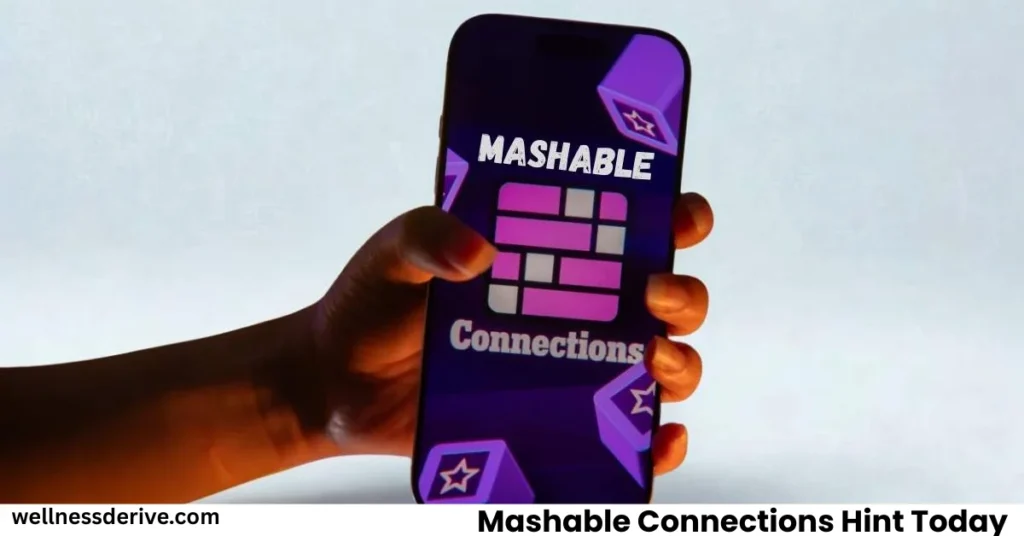If you play the New York Times Connections puzzle, you already know the feeling-sixteen innocent-looking words, four hidden categories, and a timer quietly daring you to make one wrong grouping. Some days you breeze through yellow and green. Other days blue and purple feel like word sorcery.
That’s where Mashable Connections Hint Today comes in. Instead of dumping answers, Mashable offers layered help-gentle nudges first, then progressively clearer clues, and only if you want them, full solutions. Used wisely, these hints keep the puzzle fun and fair while helping you learn the game’s logic.
This guide shows you how to get the most from Mashable’s hints, without spoiling your own “aha!” moment. You’ll learn how the puzzle works, a step-by-step solve system, advanced tactics for tricky sets, common mistakes to avoid, and how to use hints strategically so you improve over time.
What Is “Mashable Connections Hint Today”?
Mashable Connections Hint Today is a daily, spoiler-controlled guide that supports NYT Connections players. It’s designed to:
- Nudge, not give away: Start with broad category ideas, not the exact words.
- Scale up only if needed: Reveal more detail only when you choose to see it.
- Preserve the game’s joy: Help you finish the puzzle yourself, not rob you of the solve.
Think of it like having a puzzle buddy who whispers “you might be thinking animals… but not the obvious kind” instead of handing you the entire grid.
How the NYT Connections Puzzle Works
Before exploring how Mashable Connections Hint Today helps players, it’s worth understanding the structure of the daily Connections challenge. The rules are simple on the surface, but every layer hides a clever twist.
Puzzle Layout
Difficulty by Color
Limited Chances
Why It’s Surprisingly Challenging
Why Mashable’s Hints Work: The Layered Method
Mashable’s daily guide typically offers help in tiers. Use them in this order:
Mashable’s daily guide
This approach reduces frustration without stealing your win-ideal for maintaining motivation and building skill.
A Step-by-Step System to Solve Faster (Without Spoilers)
Use this five-step routine before you peek at any hint:
1) Scan the Grid for Low-Hanging Fruit
Circle obvious families: months, colors, common animals, sports, school subjects, etc. These are often yellow or green and give you momentum.
2) Park the “Double-Agent” Words
If a word clearly fits more than one idea (bass, pitch, sole, light), set it aside. Solve with the unambiguous words first.
3) Form “3-Plus-1” Groups
If you know three connect, predict the missing fourth. Ask, “What’s the natural fourth that makes this a clean set?” This stops you from forcing bad groups.
4) Test and Eliminate
Use a guess as information, not ego. A wrong grouping teaches you which theme is off. Note your learnings and adjust.
5) Save the Purple For Last
Once other sets disappear, the final category often reveals itself by process of elimination-especially if wordplay was masking the link.
Advanced Tactics for Blue and Purple Sets
When yellow and green are gone, bring out these tools:
Recognize Common Wordplay Patterns
- Homophones/homonyms: row (line/argue), sole (only/fish).
- Shared affixes: -ology words, re- verbs.
- Hidden pairs: Words that follow or precede a common partner (e.g., all can follow “book”).
- Embedded themes: Words containing a smaller word (e.g., planet names inside longer words).
Distinguish Literal vs. Abstract
- Literal: instruments, gemstones, dog breeds.
- Abstract: “things that rise,” “types of shots,” “words that can be silent.”
Use “Contrast Tests”
If you’re torn between two themes, ask which candidate fits less cleanly with the others. The oddball often reveals the real category.
Mind the Creator’s Style
Over time, you’ll notice recurring gimmicks-NYT puzzle makers love elegant misdirection. Keep a mental notebook of patterns you’ve seen.
The Smart Way to Use Mashable Connections Hint Today
Before hints: Clear the easy sets, isolate double-agents, and attempt 3-plus-1 groups.
With hints:
- Start with broad category nudges only.
- If still stuck, reveal one category to declutter the board.
- Keep full solutions as your last resort.
After finishing:
- Review Mashable’s categories and your misreads.
- Note patterns that fooled you-prefixes, homophones, “words that pair with X,” etc. This reflection reduces future errors.
A Tricky Puzzle Example
Let’s walk through a sample puzzle scenario to see how strategy and hints come together in real time. Imagine today’s NYT Connections grid included these sixteen words:
| Words | Possible Correct Group |
|---|---|
| Rose, Lily, Orchid, Daisy | Flowers |
| Violin, Trumpet, Drum, Harp | Musical Instruments |
| Mercury, Iron, Copper, Silver | Chemical Elements |
| Spring, Balance, Fall, Swing | Types of Scales or Movements |
At first glance, you might quickly spot Flowers and Instruments as two clean groups. But the remaining words-Mercury, Iron, Copper, Silver, Spring, Balance, Fall, Swing-could feel messy.
Here’s how a seasoned solver might approach it:
- Identify double-agents:
- Mercury could belong with metals or with planets.
- Spring might fit seasons or mechanical items.
- Narrow by logic:
- Iron, Copper, Silver clearly point to Elements when grouped with Mercury, making that category a strong match.
- Finish by elimination:
- The leftover words-Spring, Balance, Fall, Swing-share a subtler theme. A Mashable hint like “think motion and equilibrium” might nudge you to the right answer: Types of Scales or Movements.
This case illustrates how Mashable Connections Hint Today can save a round. A single gentle clue (like “these words all involve motion or measurement”) preserves the challenge while helping you sidestep endless wrong guesses.
By practicing with scenarios like this, you’ll learn to spot hidden patterns, manage “double-agent” words, and know exactly when to lean on hints without losing the fun of discovery.
Common Pitfalls (And Quick Fixes)
Pitfall 1: Tunnel Vision
You lock onto “instruments,” forcing bass to fit.
Fix: Try the opposite—what if it’s fish or voice types instead?
Pitfall 2: Over-literal Thinking
You expect exactly matching items only.
Fix: Consider functional groups (things that inflate; items you snap) or language rules (silent letters, rhymes).
Pitfall 3: Misreading Colors
You treat blue/purple as “impossible.”
Fix: Remember colors reflect style, not absolute difficulty. A niche pop-culture set might be easy for you.
Pitfall 4: Ignoring “Word Position” Themes
You overlook phrases like X + “light” or “high” + X.
Fix: Test before/after combos quickly: can these words pair with the same anchor?
Pitfall 5: Burning Lives on Bad Guesses
Rapid-fire guessing to “see what sticks.”
Fix: Guess with intention—every click should test a hypothesis.
Why Using Hints Can Actually Make You Better
Used strategically, Mashable Connections Hint Today does more than get you unstuck:
- Builds pattern recognition: Your brain learns to spot familiar structures faster.
- Improves cognitive flexibility: Switching between literal and abstract links trains flexible thinking.
- Supports “flow”: Light guidance keeps the challenge engaging, not frustrating.
- Encourages healthy habits: You learn when to pause, reflect, and try a fresh angle.
These are the same mental skills linked to stronger attention, reasoning, and problem-solving in broader contexts.
Sample “Solve Flow” for a Tricky Grid
- Grab the obvious (colors, months, animals) → lock one set.
- Park ambiguous words (pitch, light, sole, bass).
- Build two 3-plus-1 hypotheses (e.g., “things you can raise”).
- Use a Mashable nudge to confirm which idea is on the right track.
- Reveal one category if necessary.
- Solve the last two sets by elimination and pattern matching.
You’re done-without spoiling the whole puzzle.
A Quick, Reusable Checklist
- Scan the grid; collect obvious fours.
- Park double-agents; don’t force them.
- Build 3-plus-1 groups; test logically.
- Use one light hint if stuck.
- Reveal one set only if needed.
- Finish by elimination; review patterns afterward.
The Community Side: Share, Compare, Learn
Connections has grown a lively daily community-players swap theories, celebrate streaks, and debate the trickiest purple sets. Comparing your approach after you solve (not during) is a great way to expand your pattern library without spoiling the day’s fun.
FAQ: Mashable Connections Hint Today
Final Thoughts:
Mashable Connections Hint Today is most powerful when you treat it like a coach-there when you need guidance, quiet when you’ve got momentum. Use hints to learn the puzzle makers’ favorite tricks, not to skip the challenge. Over time you’ll: miss fewer double-agents, spot wordplay faster, save lives for when they really count, and enjoy more of those delicious “click” moments
Solve smart. Keep it fun. And when tomorrow’s grid stares back at you-remember, you’ve got a plan.




